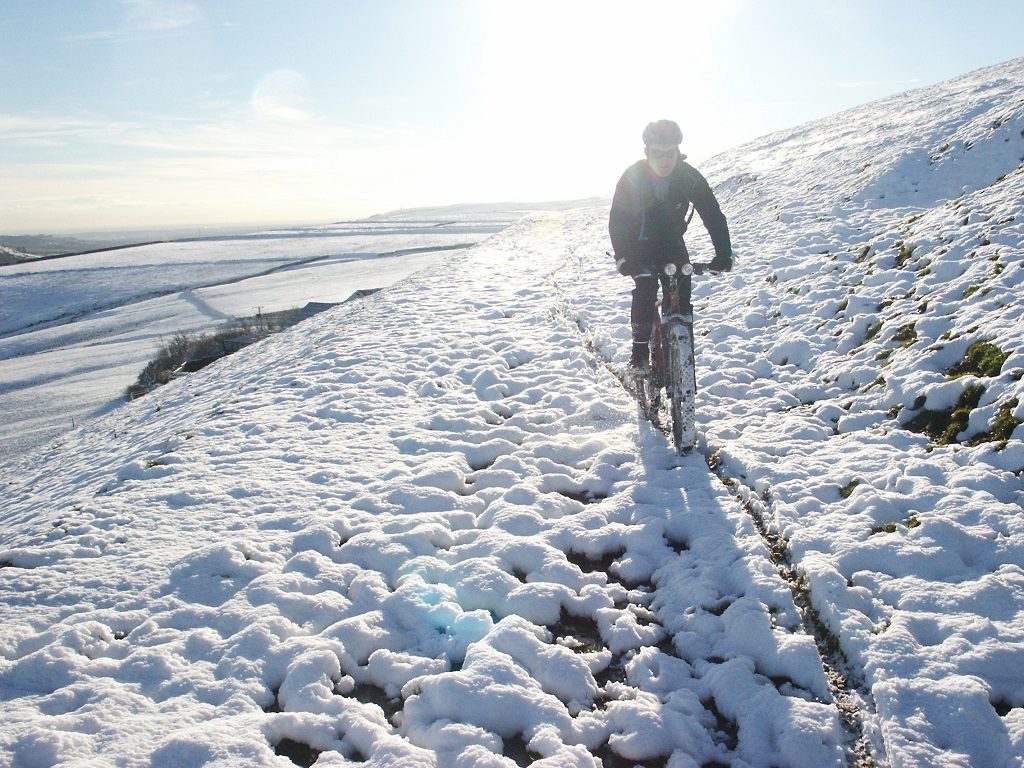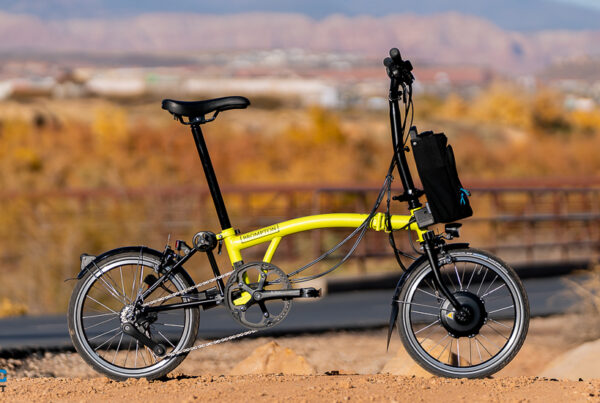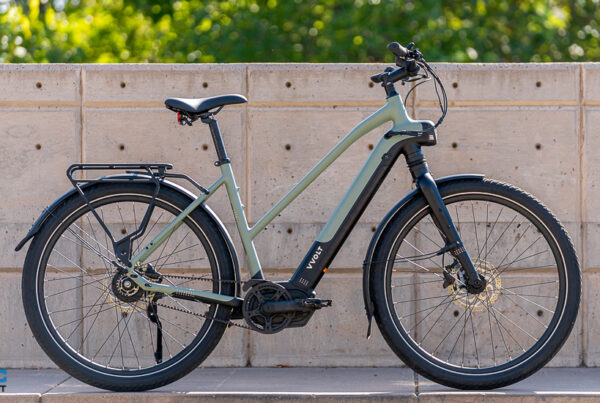Do you garage your e-bike as temperatures plummet and as snow and ice appear? Maybe you think its’s dangerous or even not possible to ride in the worst of winter conditions but as we demonstrate below, e-bikes can be the perfect tool for riding in snow and ice. In fact, once you get the hang of it, you might find yourself grabbing the e-bike and heading out for magical, snowy winter rides…
Riding in snow can be an awe-inspiring experience (copyright Richard Peace)
What Kind of eBike?
It really does depend on what kind of winter weather you get. I’ve ridden an electric powered Brompton with a front hub motor and skinny road tires on through snow, and this has all the worst attributes for an e-bike you would want to ride in snowy or icy conditions, though it does go to show what is possible. Wheel and tire (or “tyre” in the UK) size and design are particularly important when e-biking in snow. E-bikes for riding in snow and ice should ideally (but not necessarily) have:
- Larger wheels to make for a larger contact patch, providing more grip
- Larger volume tires with aggressive tread – again widening the contact patch with the tread providing extra grip too.
- In particularly icy conditions or on very compacted snow, studded tires provide the ultimate in grip and if you live in a real winter climate with snow and ice for many weeks or months of the year studded ice tires might prove give you the confidence to venture out in just about any conditions.

Even narrow road width tires with some tread on can provide good grip on pretty fresh snow, as here (copyright Richard Peace)
Of course, electric road bikes and other frame designs with narrow fork drop-outs simply won’t accommodate much wider tires and so the heavier the snow and ice the more they are at a disadvantage. That said I’ve ventured out many times in winter with patchy or thin snow and ice on the ground on my e-powered Brompton fitted with regular Schwalbe Marathon commuting tires. Indeed many road and e-road bike riders find that changing from ‘skinny’, faster summer tires to winter tires with just a bit more width and tread can make all the difference when there is just a moderate amount of snow and ice about.
At the other end of the scale, you might want to ride through heavily compacted snow and ice on roads before switching to lightly used bike paths requiring you to master deeper, uncompacted snow. This is certainly where a trekking style e-bike with the widest tires possible fitted will come into its own. Even more capable will be an e-mtb with plus width tires (plus width tires are around 2.8- to 3.25-inch wide, though there is no fixed definition.) And of course the ultimate will be fat bike tires at over 3.25 inches in width and made specifically to ‘float’ over loose surfaces like sand, deep mud and powdery snow.

20 inch wheels may not be the best choice for snow but even so the wide profile tires on this Kalkhoff compact style e-bike provide good grip on fresh snow (copyright Richard Peace)
It has to be said that many modern e-bike come equipped with very wide tires to help give some suspension effect on what are often 20kg / 45lb plus machines and this is very helpful when it comes to riding on snow. See the notes below on tire pressure in the Riding Technique section in this regard too.

This rear wheel vintage IZIP kit drive worked well in a few inches of snow with standard mountain bike tires as long as the powerful throttle control was used with care (copyright Richard Peace)
Mid-drives are probably the best option as they keep weight well balanced and low down, ideal for trickier riding conditions. Rear hubs are also good with most committed winter e-bikers being wary of front wheel hubs which may be more prone to wheel spin and loss of traction than the other types of motor set up. Having said that wheel size, bike weight distribution and good riding technique and judgement of conditions are equally if not more important and most e-bikes, perhaps with just a change of tires allow you to get out and ride in at least moderately snowy and icy conditions. If you are going to be tackling really thick snow a really powerful mid-drive is probably the best option in which case the next paragraph on the importance of large batteries for winter riding is doubly important!
Large sized batteries can come into their own in winter too. The battery itself performs less well in cold and so you will get less range. Add to this it takes much more effort to push snow out of the way (much more on an e-fat bike) and you might easily find you are doubling your power consumption or more compared to benign summer riding conditions.
Class 2 bikes with throttle only control can be great when going off road in thicker snow when you are unsure of the course the bike wants to take as you may not be sure exactly what’s under the snow at all times – using throttle only allows you to balance much easier in these conditions than when you are trying to pedal at the same time.

Winter e-triking on a Babboe tilting e-trike with mid-drive (thismomsbikes)
What about taking heavier loads and children on snow? Thismomsbikes thinks they have found the answer in the form of Babboe’s e-trike that gives that extra stability – it’s best just to hand over to the article author, Sara Hastings-Simon:
‘….I am a very cautious (read: anxious) winter biker, with or without the kids. This trike solves that all: it feels SOLID. You can ride no handed, steer with your elbows, sit back and relax at red lights; I’ve managed to skid the back wheel a bit when going really fast over ice but never to the point of instability. No checking the frost bike report or cautiously steering over patches of ice. It’s not a requirement to have a trike to carry kids or ride in the snow/ice – I know many people who do it happily without issue – but if that isn’t you then a trike may be the answer, and if you are someone who tenses up and carries that anxiety in your neck and shoulders while riding then you will love the feeling of freedom and stability draining the stress from your shoulders, and they will thank you for buying this trike. I use it in the snow/ice even when I don’t have the kids.’
Riding Technique
Remember riding on snow ice does require you to modify your typical e-bike behavior and much of this is just common sense and doesn’t require any elevated riding skills beyond the capability of most e-bikers.
Go slower and pedal, steer and brake more gently. Sudden movements and quick starts and stops mean more force on your tire contact patch and so an increased risk of skidding. This is especially so if you are not on an e-mtb or e-fat bike and / or don’t have studded tires. If you have a throttle control option on your e-bike be apply it slowly and carefully.
A good range of gears will help in this regard – it’s obviously not possible on a single speed to apply gentle pedal pressure at all speeds.

Large wheels, broad treaded commuting tires and gentle use of power, gears and steering all make for easy progress on this firm, compacted trail of ‘dry’ snow (copyright Richard Peace)
You may well find that dropping tire pressures helps grip in snow and ice too. As a very general rule you will get roughly 50% better traction in soft conditions underwheel if you decrease the recommended tire pressure by about 50%, though if you are riding in very hardpacked conditions or hopping onto tarmac this may be too much. Note that fat bike tires can actually run at pressures of less than 5 psi in very soft conditions. If you expecting to encounter lots of ice regularly a spare pair of studded tires for winter use are definitely the way to go. Schwalbe’s Ice Spiker Pro gets great writeups. For proof of how much grip you can get check out the following video (OK not an e-mtb but these tires do just the same job on an e-bike…):
Once you get experienced you never know, you might just find yourself heading out in the snow just to play around like the folks at Surly ‘testing out’ just what their Big Easy e-bike is capable of….
Learn to Read the Conditions

Experienced winter e-bikers know how to recognize the best kind of snow for riding in! (Photo: Surly)
Experienced riders know that snow can actually be your friend and provide grip – especially if fresh and loose and hasn’t yet started to melt and go mushy. By contrast ice is generally your enemy. Aggressively treaded tires help and metal studded tires are best of all. The best riding tactic is to roll over ice at a slow speed not pedaling if possible. If you do need to pedal select as low a power level as is practical and pedal gently and in a low gear with a high cadence.
It all boils down to realizing the fact that there isn’t one type of winter riding – conditions under wheel can vary enormously so it is a case of equipping your e-bike for the conditions you are likely to find during your winter and to get out there and ride carefully but often to gain experience of local conditions – which roads are swept, which are likely to be very icy for days on end and best avoided and were the most fun trails are!
Personally, I much prefer off-road conditions in parks and on bike paths and trails after snow – you simply don’t have to contend with motor traffic which becomes extra hazardous after snowfall. If I do need to get somewhere quickly by road I will often stick to main roads, which I wouldn’t normally do – in all but the worst conditions these are ploughed and car exhausts also help melt snow, so I will most likely be riding on tarmac. By choice though I will seek out little used trails though fresh snow.
Either ways you could just find you get hooked on winter riding and that it actually has practical benefits too – as this article on e-biking in winter notes ‘Another benefit is commuting on the Big Easy during a Minnesota winter. Riding to work in very cold and snowy weather is taxing and requires a bigger time commitment. Having electric assist allows me to maintain similar commute times and keeps me fresh on days I want to ride my other bikes for fun. On heavy snow days, I often get to work faster than driving. It is a great feeling passing long lines of cars stuck in traffic due to snowy roads.’
Caring for Your eBike in Winter
Of course biking in snow isn’t all about the riding, you need to keep the e-bike in extra good condition to cope with the harsh environment and you need to look after yourself whilst riding too. Here’s my top tips:
- Keep your battery warm – this isn’t just about keeping it indoors when not using it. Many battery manufacturers sell neoprene covers or similar which reviews suggest work reasonably well in extending winter range.
- Chains are particularly prone to rusting if ridden on salty roads so carry a small bottle of wet chain lube on the bike and use it very regularly.
- Keeping warm in winter – clearly warm clothes are important but I had a struggle to keep my hands warm in the coldest of winters until I discovered pogies or mitt bar attachments which shield your hands from the worst of the wind and let your wear thinner gloves underneath – much easier to use control buttons with than thicker gloves.
Stay tuned for more e-bike news and reviews and thanks for reading!
-Rich
Related
Source link








